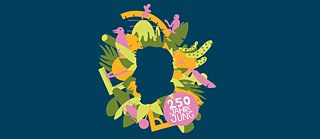“Still young at 250!”: Exhibition at the Humboldt Forum
“We didn’t aim to make it a laudatory homage.”

To celebrate the 250th birthday of Alexander von Humboldt, the Stiftung Humboldt Forum is organising a two-day festival together with the Goethe-Institut. On 13 September, the exhibition "The Nature of Things: Humboldt, Comings and Goings" will open in Berlin as part of these festivities. It shows 14 contemporary artists in dialogue with 14 historical artistic positions. We spoke about it with curator Halim Badawi.
By Annette Walter
Mr Badawi, in the exhibition, 14 artists explore the tradition of the researcher and scientist Alexander von Humboldt in Latin American art on the occasion of his 250th birthday. You already showed your exhibition in a slightly different form in Bogotá in May. How was the response?
It received a lot of attention. 40,000 people visited the show in a period of two months. The media also showed a great interest in it.

A precursor to our environmental movements
In what way does your exhibition differ from the conventional reception of Humboldt?
This is the first time Humboldt’s legacy has been examined in a critical exhibition. We didn’t aim to make it a laudatory homage or to rewrite his biography.
Now you’re showing the exhibition for the first time in Berlin. To what extent has the tradition of Humboldt influenced Latin American art to this day?
Humboldt was a fundamental figure in the iconography of nations like Cuba, Mexico, Venezuela, Colombia, Ecuador and Peru. His journals, which he reproduced in books and magazines on his return to Europe, contributed a great deal to how Latin America is viewed; a view that continues today. In contemporary art, numerous artists, especially from Colombia, were and are interested in critically examining Humboldt’s intellectual and visual heritage. It is a legacy that was a precursor to our environmental movements and helped us better perceive ourselves in our territory.

Humboldt's crocodile is not Hegel's
Could you explain the critical perspective of Humboldt’s legacy in more detail?
The ideas developed by Humboldt paved the way for modern science and the construct of a new visuality in Latin America. But they were also responsible for an invasion on the South American continent. This led to structures being established that are based on exploitation, appropriation and destruction of natural resources. Our exhibition aims to illustrate this ambiguous heritage; the opposing ways knowledge was acquired. For example, we’re showing several artworks by the Colombian José Alejandro Restrepo. He was born in 1959 and created the famous 1993 installation “Humboldt's Crocodile is Not Hegel's,” which can be seen now. It is a classic of contemporary Colombian art. The artist refers to a discussion that actually took place between Hegel and Humboldt and dealt with the size of crocodiles in the New and Old World. Restrepo looks at this discussion with a video installation that sheds light on how various fictions and narratives of South American history emerged.
But you’re also showing European artists like the Spaniard José Luis Bongore, who walked in Humboldt’s footsteps. What is his intention?
Like Humboldt, he visited the waterfall Salto del Tequendama near Bogotá and created a monumental video installation based on this natural spectacle. Bongore shows us the tragedy of this place: the Río Bogotá, the neighbouring landscape and the waterfall have become victims of excessive urbanisation and destructive pollution.
